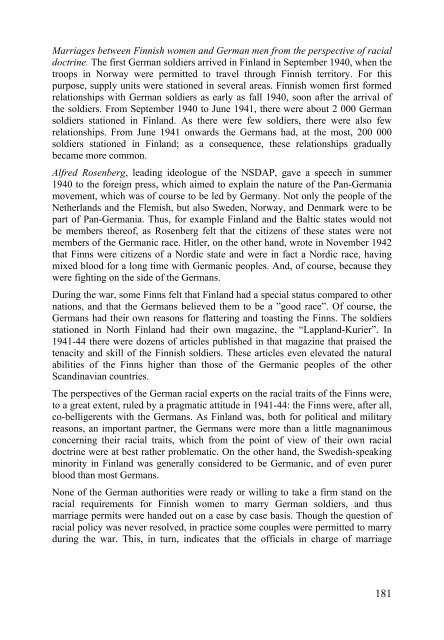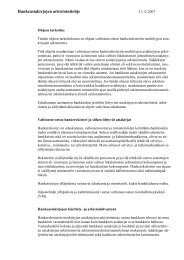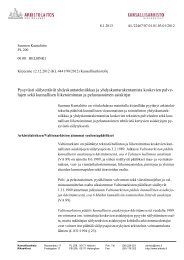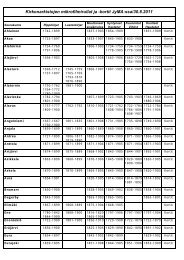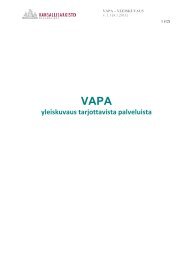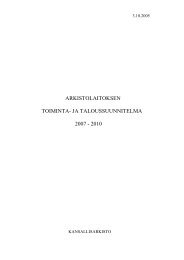Saksalaisten sotilaiden lapset. Ulkomaalaisten sotilaiden lapset ...
Saksalaisten sotilaiden lapset. Ulkomaalaisten sotilaiden lapset ...
Saksalaisten sotilaiden lapset. Ulkomaalaisten sotilaiden lapset ...
You also want an ePaper? Increase the reach of your titles
YUMPU automatically turns print PDFs into web optimized ePapers that Google loves.
Marriages between Finnish women and German men from the perspective of racial<br />
doctrine. The first German soldiers arrived in Finland in September 1940, when the<br />
troops in Norway were permitted to travel through Finnish territory. For this<br />
purpose, supply units were stationed in several areas. Finnish women first formed<br />
relationships with German soldiers as early as fall 1940, soon after the arrival of<br />
the soldiers. From September 1940 to June 1941, there were about 2 000 German<br />
soldiers stationed in Finland. As there were few soldiers, there were also few<br />
relationships. From June 1941 onwards the Germans had, at the most, 200 000<br />
soldiers stationed in Finland; as a consequence, these relationships gradually<br />
became more common.<br />
Alfred Rosenberg, leading ideologue of the NSDAP, gave a speech in summer<br />
1940 to the foreign press, which aimed to explain the nature of the Pan-Germania<br />
movement, which was of course to be led by Germany. Not only the people of the<br />
Netherlands and the Flemish, but also Sweden, Norway, and Denmark were to be<br />
part of Pan-Germania. Thus, for example Finland and the Baltic states would not<br />
be members thereof, as Rosenberg felt that the citizens of these states were not<br />
members of the Germanic race. Hitler, on the other hand, wrote in November 1942<br />
that Finns were citizens of a Nordic state and were in fact a Nordic race, having<br />
mixed blood for a long time with Germanic peoples. And, of course, because they<br />
were fighting on the side of the Germans.<br />
During the war, some Finns felt that Finland had a special status compared to other<br />
nations, and that the Germans believed them to be a ”good race”. Of course, the<br />
Germans had their own reasons for flattering and toasting the Finns. The soldiers<br />
stationed in North Finland had their own magazine, the “Lappland-Kurier”. In<br />
1941-44 there were dozens of articles published in that magazine that praised the<br />
tenacity and skill of the Finnish soldiers. These articles even elevated the natural<br />
abilities of the Finns higher than those of the Germanic peoples of the other<br />
Scandinavian countries.<br />
The perspectives of the German racial experts on the racial traits of the Finns were,<br />
to a great extent, ruled by a pragmatic attitude in 1941-44: the Finns were, after all,<br />
co-belligerents with the Germans. As Finland was, both for political and military<br />
reasons, an important partner, the Germans were more than a little magnanimous<br />
concerning their racial traits, which from the point of view of their own racial<br />
doctrine were at best rather problematic. On the other hand, the Swedish-speaking<br />
minority in Finland was generally considered to be Germanic, and of even purer<br />
blood than most Germans.<br />
None of the German authorities were ready or willing to take a firm stand on the<br />
racial requirements for Finnish women to marry German soldiers, and thus<br />
marriage permits were handed out on a case by case basis. Though the question of<br />
racial policy was never resolved, in practice some couples were permitted to marry<br />
during the war. This, in turn, indicates that the officials in charge of marriage<br />
181


